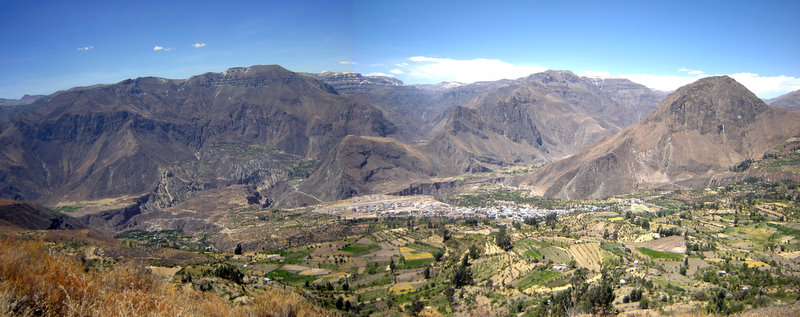Cotahuasi Canyon facts for kids
The Cotahuasi Canyon is a super deep canyon in Peru, close to the city of Arequipa. It's one of the deepest canyons on Earth! Imagine a giant crack in the ground. This canyon is about 3,354 meters (11,004 feet) deep. That's more than twice as deep as the famous Grand Canyon in the USA!
The Cotahuasi River carved out this amazing canyon. It flows between two huge mountains: Coropuna, which is 6,425 meters (21,079 feet) tall, and Solimana, which is 6,093 meters (19,990 feet) tall. The canyon stretches from the snowy slopes of Solimana all the way to where the Cotahuasi River joins the Ocoña River. This happens near a small village called Chaucalla.
The Cotahuasi River starts high up at Lake Wansuqucha. This lake is more than 4,750 meters (15,584 feet) above sea level! As the river flows, other smaller rivers join it. These include the Wayllapaña River and the Huarcaya River. Later, the Maran River also joins, and together they form the Ocoña River. This river eventually flows into the Pacific Ocean.
Contents
Where is Cotahuasi Canyon Located?
Cotahuasi Canyon is in the highest part of the Andes mountains in Arequipa, southern Peru. It's found between 14°40´22" and 15°35´27" south latitude, and 72°19´15" and 73°18´08" west longitude.
This area has very steep land. Rivers and deep valleys cut through the landscape. The elevation here ranges from 1,000 meters (3,281 feet) to 6,093 meters (19,990 feet). Because of these big changes in height, there are 19 different types of natural environments here! Even though times are changing, people in this remote region still follow many old traditions. They have kept practices that are no longer common in nearby areas.
How to Get to Cotahuasi Canyon
There is only one main road that leads to the canyon. It goes through Chuquibamba and then Aplao. This road starts from the Panamerican Highway near Arequipa.
You can take a bus from Arequipa to Cotahuasi. Four different bus companies offer daily trips. Buses usually leave between 4 and 6 pm. The bus ride takes about 10 to 12 hours. Part of the road is not paved after Chuquibamba. The journey also goes very high up, crossing a mountain pass that is 4,500 meters (14,764 feet) high. This pass is located between the Coropuna and Solimana mountains.
Cotahuasi: A Protected Natural Area
The Cotahuasi Subbasin is a special protected area. It was made a "landscape park" in 2005. This park covers a huge area of 4,905.5 square kilometers (1,894 square miles).
This natural reserve helps protect a place where people and nature live together in harmony. It's like a small, preserved world. The challenging landscape, with its steep hills, has led to unique features. For example, you can see many ancient agricultural terraces built into the mountainsides.
Farming in Cotahuasi
Farmers in the reserve grow many organic plants. These include kiwicha, quinoa, mint, dark maize, llacon, fava beans, oca, peas, chulpi maize, anise, and tarwi. Most of these crops are grown to feed the people living in the province. This means very little is produced for export.
The people here can feed themselves thanks to smart farming methods. They use eco-friendly techniques and manage water carefully. They also use better seeds and protect different types of plants. Farmers also raise livestock to help with food supply.
Tourism and Nature in Cotahuasi
The Cotahuasi landscape reserve is a truly special place to visit. It has a huge variety of plants and animals. Many medicinal plants grow here, like muña, retama, tara, coca, jara, ruda, kiwicha, and yareta.
The landscapes are very diverse. You can find warm river areas at the bottom of the canyon. Then, as you go higher, you reach cold desert areas on the mountain tops. The Cotahuasi reserve has 12 different types of ecosystems!
There are also many old structures built by the Inca and pre-Inca people. These include the many agricultural terraces that are still used today. The region is also rich in culture and old traditions. The Andean people here have preserved their weaving skills, colonial churches, and ancient Inca paths. They also celebrate many colorful festivals.
See also
 In Spanish: Cañón de Cotahuasi para niños
In Spanish: Cañón de Cotahuasi para niños
- Colca Canyon
- Cotahuasi Subbasin Landscape Reserve
- Natural and Cultural Peruvian Heritage
- Wiñaw



